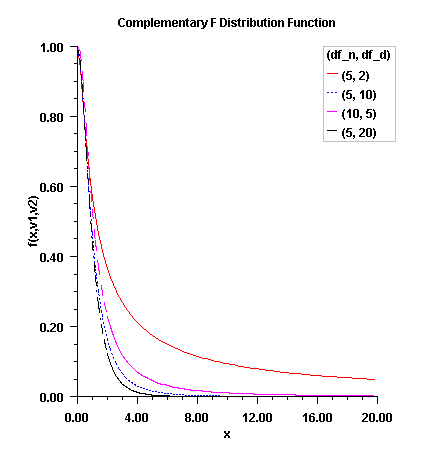COMPLEMENTARY_F_CDF Function
Evaluates the complement of the F distribution function.
Usage
result = COMPLEMENTARY_F_CDF (f, df_numerator, df_denominator)
Input Parameters
f—Scalar float value for which Pr(x > f) is to be evaluated.
df_numerator—Scalar float value indicating the numerator degrees of freedom. df_numerator must be positive.
df_denominator—Scalar float value indicating the denominator degrees of freedom. df_denominator must be positive.
Returned Value
result—The probability that an F random variable takes a value greater than f.
Input Keywords
Double—If present and nonzero, then double precision is used.
Discussion
COMPLEMENTARY_F_CDF evaluates one minus the distribution function of a Snedecor’s F random variable with df_numerator and df_denominator. The function is evaluated by making a transformation to a beta random variable, then evaluating the incomplete beta function. If X is an F variate with n1 and n2 degrees of freedom and Y = (n1X)/(n2 + n1X), then Y is a beta variate with parameters p = n1/2 and q = n2/2. COMPLEMENTARY_F_CDF also uses a relationship between F random variables that can be expressed as:
FF(f, n1, n2) = FF(1/f, n2, n1)
where FF is the distribution function for an F random variable.
This function provides higher right tail accuracy for the F distribution.
|
|
Example
This example finds the probability that an F random variable with one numerator and one denominator degree of freedom is greater than 648.
PRO t_complementary_f_cdf_ex1
F = 648.0
df_numerator = 1.0
df_denominator = 1.0
p = COMPLEMENTARY_F_CDF(F,df_numerator, df_denominator)
PRINT,"The probability that an F(", $STRTRIM(STRING(df_numerator,Format="(f3.1)"),2),",",$
STRTRIM(STRING(df_denominator,Format="(f3.1)"),2),$
") variate is greater than ", $
STRING(F,Format="(f5.1)")," is ",$
STRING(p,Format="(f6.4)")
END
Output
The probability that an F(1.0,1.0) variate is greater than 648.0
is 0.0250.






